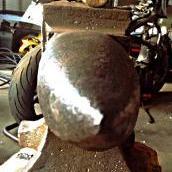
haddockkl
Members-
Posts
25 -
Joined
-
Last visited
Recent Profile Visitors
-
Fixing (or trying to) a really sad Hay Budden
haddockkl replied to haddockkl's topic in Anvils, Swage Blocks, and Mandrels
If I ever attempt this again I'll try a smaller gap between face and body, and a bigger electrode, and +1 on running a straight bead. -
Fixing (or trying to) a really sad Hay Budden
haddockkl replied to haddockkl's topic in Anvils, Swage Blocks, and Mandrels
Thomas, that is the plan. At home on a concrete surface I am getting between 3-4in of bounce from a 10in drop of the hammer. Can't say how much of that is the result of my welding prowess, or because I have a 1.6in homogenous plate on top of a wrought iron body. Ring and rebound is pretty consistent over the entirety of the work surface welded to the body and distinctly flatter on the tail where it is not welded. -
Fixing (or trying to) a really sad Hay Budden
haddockkl replied to haddockkl's topic in Anvils, Swage Blocks, and Mandrels
At least 25%, I got three bounces from one 8in drop, but it was sitting in my back seat, I'll report back when its on a solid surface and I can actually measure the rebound. -
Fixing (or trying to) a really sad Hay Budden
haddockkl replied to haddockkl's topic in Anvils, Swage Blocks, and Mandrels
Scooped it up on the way to work, it rings and rebounds nicely. -
Fixing (or trying to) a really sad Hay Budden
haddockkl replied to haddockkl's topic in Anvils, Swage Blocks, and Mandrels
Yeah, a professional welder I am not. I was running 160 amps for the interior welds between the plate and body about 110 amps for the exterior welds. I swirled my bead to try taking up more of the 1/2in gap that had to be filled. If I had it to do over I would reduce the gap to 3/8. The next phase is to grind everything even and pretty it up. If the face pops off I would be suprised, but it will probably hold me over until I find a better anvil now, it isn't officially a door-stop yet. -
Fixing (or trying to) a really sad Hay Budden
haddockkl replied to haddockkl's topic in Anvils, Swage Blocks, and Mandrels
Got it done, there are most definitely slag inclusion aplenty but that tine is not coming off. I left it out to cool and will collect it in a day or two from the folks house as time allows. Pre-heated to about 350 and started welding. After chipping what I could of the slag from the recent weld I'd flip it for the next pass. 7018 rod might not be the best for this operation as the slag was pretty tenacious. I'll report back on if it rings or not, I think rebound is good because it bounced a hammer pretty satisfyingly when it was allowed to fall 8-10in driven by only its weight. -
Fixing (or trying to) a really sad Hay Budden
haddockkl replied to haddockkl's topic in Anvils, Swage Blocks, and Mandrels
Got on the welder this morning, managed to get the new work surface attached but couldn't get very far because I kept blowing my 40amp breaker. Going to take it to my parents place next week and see about getting a better weld. No problems welding between the body and new top at least. -
Fixing (or trying to) a really sad Hay Budden
haddockkl replied to haddockkl's topic in Anvils, Swage Blocks, and Mandrels
Even poor weld will probbly yeild rebound with this 1.6in thick plate, I get some bounce just whacking it on the floor. -
Fixing (or trying to) a really sad Hay Budden
haddockkl replied to haddockkl's topic in Anvils, Swage Blocks, and Mandrels
I like it, but I'm a little way from fatherhood yet, let alone grandkids. For now the grunt work falls on my shoulders. Good thing the Pritchel holes will be easier. Should have it ready to weld by the weekend. -
Fixing (or trying to) a really sad Hay Budden
haddockkl replied to haddockkl's topic in Anvils, Swage Blocks, and Mandrels
Hardee hole, en route. I've got a big square file with some agressive teeth that will make it a little prettier. -
Fixing (or trying to) a really sad Hay Budden
haddockkl replied to haddockkl's topic in Anvils, Swage Blocks, and Mandrels
I have a gerry rigged the anvil to an engine stand. The batting material is insulation for a furnace door to try limiting heat migration into the engine stand. So here is the plan: -Lay stand on its back and orient the anvil in the upright position and lay the tine piece on it. -heat prodigeously with a large wand torch, bringing the tine to a minimum of 500 degrees, then tack weld the plate in place. -lay engine stand back down, now that the anvil is horizontal simply stand over it and going from rear to front lay successive beads of weld. After a bead or two I will rotate the anvil to prevent any warpage from asymetrical heating. During this phase I'll monitor the temp of the tine and try keeping it below 800deg F. -Upon complete filling of the gap I'll try ignoring it for several hours until it is cool enough to handle, once it is cool I'll set the anvil on some fire brick and re-heat the top to between 700-800 deg to relieve some stress and then it's time to start grinding and shaping. -
Fixing (or trying to) a really sad Hay Budden
haddockkl replied to haddockkl's topic in Anvils, Swage Blocks, and Mandrels
The Fire Fighters I have known are usually some pretty accomodating folks, I'm sure I could talk a few into hozing down some really hot steel, even if it costs a few dollars or steaks. -
Fixing (or trying to) a really sad Hay Budden
haddockkl replied to haddockkl's topic in Anvils, Swage Blocks, and Mandrels
How about a creek or moving body of water? Is there a calculation for the minimum water velocity required to push through the steam barrier? -
Fixing (or trying to) a really sad Hay Budden
haddockkl replied to haddockkl's topic in Anvils, Swage Blocks, and Mandrels
No worries, I have a lot to learn as well and getting discourse like this is of great value. I have come to some conclusions since this thread has kicked off and will be pre-heating the fork piece to 500-600 degrees to avoid the HAZ cracking as much as possible. Thankfully I don't have to hang an M1 Abrhams tank off this so even if there is some underlying cracking I am pretty sure there will still be enough tie in to the body that this should at least work as a solid surface to beat on. After welding I'll try bringing it to about 800 deg to stress releive it a bit, that is also on the high side for tempering so hopefully re heat treating the top won't be necessary, even if it is a little soft it will be harder than the iron body, I want it to be a little softer than my hammer and as long as the top is on there securely I can always have the top surface ground flat again then re-heat and harden it. -
Fixing (or trying to) a really sad Hay Budden
haddockkl replied to haddockkl's topic in Anvils, Swage Blocks, and Mandrels
I understand they require an awful lot of water to quench and anvil and harden it. My hope is to keep the top at or below the temp it would temper too much. If it gets too soft the I guess it will be time to make a bumper fixture and have a bonfire near some moving water.

